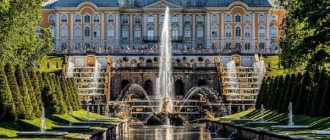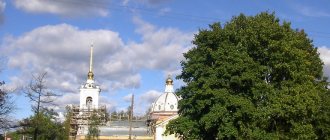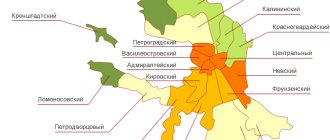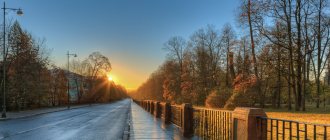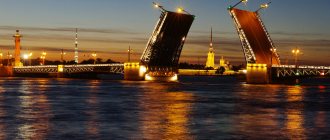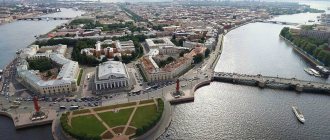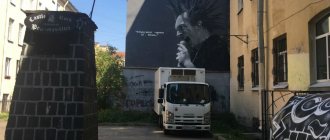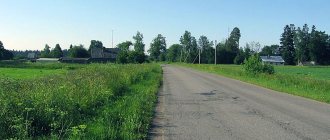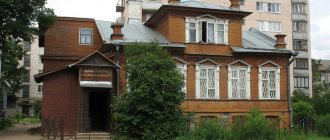In the old days in Russian the word “red” was used in a slightly different sense - beautiful, beautiful, handsome. Therefore, there are many villages on Russian land that bear the names “Red”, “Red” or “Red”. One of them is the city of Krasnoye Selo (Leningrad Region), which is part of the district of St. Petersburg with the same name.
Story
This city was founded under Peter the Great, back in 1714. It was then that the construction of the first paper mill in Russia began in this town. For construction and production needs, serfs were transported here from the village of Krasnoe near Moscow. They were settled not far from the site of the future mill. Time passed, the village grew, and it began to be called the same as the native village of the workers.
Red village was located in a picturesque area, among forests and lakes. Tsar Peter gave it to his wife, Catherine the First, and she ordered a wooden palace and church to be built here (unfortunately, they have not survived to this day). In 1735, with funds allocated by Anna Ioannovna, a new stone Trinity Church of St. Catherine the Great Martyr was built. Today it is one of the most ancient churches in the entire Leningrad region. During the reign of Catherine the Second, Krasnoye Selo began to develop in a different direction, in the military. The guards of the St. Petersburg garrison were stationed here. Until 1811, this village was officially called “Palace Red Village”. Until 1914, the Leningrad region was called the St. Petersburg province. After that, it was renamed twice more. But the name of the city has remained unchanged to this day.
Triumphal Arch of Victory
The arch is a monument to the 70th anniversary of Victory in the Second World War. It was opened in May 2015. It depicts figures of warriors, wreaths, and the inscription “Glory to the conquering warriors.” The arch is lined with granite and is beautifully illuminated in the evening. The simple yet majestic architecture of the monument perfectly complements and decorates the main thoroughfare of the city.
Location: Lenin Avenue - 99.
Krasnoye Selo is the military capital of Russia
As noted above, even under Catherine II, military maneuvers were carried out in this area. During the reign of Alexander the First, Krasnoye Selo and its surroundings completely turned into the summer military capital of the empire. His younger brother, Grand Duke Mikhail Pavlovich, who idolized military affairs, built a modest wooden palace for himself next to the barracks and spent almost all his time with the troops. During all the warm months of the year, exercises and parades were held here, at which the emperor himself was present.
How to get there from St. Petersburg, what and how long the journey takes
Cruise St. Petersburg-Moscow-St. Petersburg
Getting to Krasnoe Selo from St. Petersburg is quite easy. Buses and trains go here. There are also many minibuses available, or you can go in your own car.
The cost of a bus ticket on the route Krasnoe Selo - St. Petersburg is about 40 rubles*. Buses No. 145, 301, 481 and some others travel through Krasnoye Selo.
You can take a minibus at stops near the metro station:
- Minibuses K-145, K-445, K-65-V and K-650B depart from Avtovo via Veteranov Avenue.
- Getting off at Moskovskaya, you can take minibuses K-449, K-403 and K-636.
- K-488 and K-546 go from the Kirovsky Zavod stop.
The closest stops to Krasnoye Selo are: at the intersection of Lenin Square and Pervo Maya Street, and directly on Pervo May Street.
You can view the current train schedule on the website.
Also, the distance from St. Petersburg to Krasnoe Selo can be covered by taxi or your own car, since the drive is only 30 kilometers. You can get a convenient route on the map by following the link.
Main square
Soviet time
After the October Revolution, the forces of the White Guard army concentrated in Krasnoe Selo. From here they prepared for the assault on Petrograd. In 1925, the village of Krasnoye Selo received city status, and from that moment on it began to develop along a new path. However, during the Patriotic War, the Nazis, sweeping away everything around them, broke into Krasnoye Selo. The Leningrad region was occupied by the German invaders, and Leningrad itself was under siege. After the end of the war, the Krasnosel residents began to put their dilapidated city in order. New multi-storey buildings, schools and kindergartens, hospitals and other institutions were built.
Monuments to military exploits
The city of Krasnoe Selo forever entered the history of the siege of Leningrad. From the Duderhof Heights captured by the Nazis, artillery shelling of the besieged city was carried out from long-range guns. Only in January 1944 did the Red Army manage to storm German fortifications.
- On the occasion of the 70th anniversary of Victory in the Great Patriotic War, one of the three triumphal arches built in 1945 to welcome returning Soviet soldiers was restored in Krasnoe Selo. It is located on the Gatchina Highway, in the center of the square with a roundabout.
- At the foot of Orekhovaya Mountain, the “Explosion” monument was erected in memory of the guns from the cruiser “Aurora” stationed here in September 1941. On the southern slope of Orekhovaya Mountain a memorial was erected to the “Auror Sailors” who laid down their lives in an attempt to repel the enemy offensive.
In the symbolic artillery courtyard there is a military relic - the remains of a ship battery gun and the “Bastion of Cannons”, depicting nine ship armored turrets.
Memory of an aviation pioneer
The relief of the Dudergof Upland contributed to one of the first tests of heavier-than-air aircraft in world history in this area. The famous Russian engineer, Rear Admiral A. Mozhaisky carried out the flight of the first aircraft he designed here in 1883 - 1885. The village was named after him, and a monument to the first aircraft builder was erected at the intersection of the Gatchina and Kingisepp highways.
New time
As noted above, the founding date of the city of Krasnoe Selo (Leningrad Region) is 1714, therefore, this year in mid-September (by decision of the authorities of the city of St. Petersburg) it will solemnly celebrate its three hundredth anniversary. By its status, the city is considered a municipal entity, the enclave of which includes the villages of Khvoinoye and Mozhaisky. It also includes 2 historical districts - Skachki (between the Gatchina railway line and the Gorelovsky overpass) and Mozhaisky-Dudergof (between Krasnoye Selo and the Dudergof lakes). These places are not of particular interest to tourists, except for the famous Trinity Church, located in the center of the city of Krasnoye Selo (Leningrad region). In principle, everyone in St. Petersburg knows how to get here. It is located only 11 kilometers from the northern capital, on the hills of the Izhora Upland. Here, at the foot of the hill, is the Nameless Lake, a favorite vacation spot for St. Petersburg residents. By the way, in 2011 it was recognized by environmentalists as the cleanest in the entire region. The Gatchina-Baltiysk – St. Petersburg railway line runs through this place. The Krasnoe Selo station is located on the eastern outskirts of the city. You can also get here by car along the Tallinn Highway, spending only 15-20 minutes on the road.
What will surprise Duderhof?
There is a wonderful natural monument here, the highest place in St. Petersburg - the Duderhof Heights (176 m). Among the hills formed by the movement of an ancient glacier, Voronya and Orekhovaya Mountains rise, and Duderhof is located in the hollow between them.
The hill has a special microclimate, which differs markedly from the climate of the surrounding Leningrad region. And the vegetation on these hills is unique to the northwest. Vast maple-ash forests with the addition of hazel, linden, viburnum and currants are called Nagorny Park. Tourists come here to admire the distant panorama of the northern capital and the Neva Bay; in clear weather, St. Isaac's Cathedral and other sights of St. Petersburg and Krasnoe Selo are clearly visible. The Duderhof Heights are on the UNESCO List of World Cultural Heritage Sites.
Train station Mozhaiskaya
The station building 1899 at Mozhaiskaya station is an example of industrial architecture with Art Nouveau elements.
Hospital of the Community of the Sisters of Charity of St. George
The Hospital of the Community of the Sisters of Charity of St. George (1900-1902), designed by the architect G. I. Lyutsedarsky in the romantic modern style, consists of several two- and three-story buildings in the center of an ancient park. Some resemble toy castles with turrets. The complex, which also includes the Invalid Homes (1879 – 1883), is a cultural monument of regional significance.
Dudergof is interesting for its whole complex of attractions of St. Petersburg Krasnoye Selo, dating back to the 2nd half of the 19th and early 20th centuries.
Krasnoe Selo, Leningrad region: attractions and natural monuments
The town is not of great interest from an architectural point of view. Little has been preserved here from the times when it was considered the summer military capital of the empire. The most beautiful building in the city, of course, is the Church of the Holy Trinity, which was built under Anna Ioannovna and is a wonderful example of Baroque architecture. However, since these times it had to be restored several times, as a result of which the appearance of the temple was partially changed. There is also a church of Alexander Nevsky in the city. From the palace buildings, only the two-story building of the kitchen of one of the royal palaces has survived today, as well as the unremarkable wooden building of the palace of Grand Duke Mikhail (the youngest son of Paul the First). In Soviet times, a memorial to the heroes of the Great Patriotic War was erected in the city. Among the city's attractions one can also highlight the Bridges Museum, dedicated to the history of the development of railway transport in Russia.
HOW TO KNOW...
At the beginning of the 20th century, this part of the city still remained an elite holiday village. It was here that in 1906 the first project of suburban electric trains in Russia, the Oranienbaum Electric Line, began to be implemented. Oranienbaum, however, remained only in name: before the revolution, the section from the Narvskaya Zastava to Strelna was completed, after which the project died out.
The war destroyed many architectural monuments, and later mass construction began, and the land finally lost its attractiveness.
The potential of the Krasnoselsky district was again discussed at the beginning of the 21st century. I would like to believe that the area with a unique landscape, which has been an elite area for several centuries, will gradually gain strength again, attract the attention of citizens, investors and authorities, and living along the Peterhof Highway will again become prestigious and, most importantly, comfortable.
We are always open to dialogue with you ! Join our VKontakte group: Your own apartment and Siberians in St. Petersburg and ask all your questions about life in St. Petersburg.
Are you planning to buy an apartment in St. Petersburg? Watch the full Video review of new buildings in St. Petersburg , leave a request using the link: “Get video” and we will send you a recording!
Where to stay in the city of Krasnoe Selo (Leningrad region): hotels and hotels
St. Petersburg is the most beautiful city in Russia. Every year millions of tourists come here to explore its many attractions. They are located either in the city itself or in its suburbs. There are practically no large hotels in Krasnoye Selo, only small family hotels. This is probably why the town is not very popular from a tourism point of view. Among the guest houses in this suburb of St. Petersburg, one can note the RedVill mini-hotel. Here you can find quite decent service and delicious cuisine.
Businesses and work in the area
Krasnoselsky District Administration building
On the territory of the Krasnoselsky district there are twenty-six large industrial enterprises, one scientific, eight construction, three transport and three housing and communal services enterprises.
The largest industrial enterprises of the Krasnoselsky district of St. Petersburg include - , "LEMZ", the associations "LenBytKhim", "Kontakt" and "Komplekt", Krasnogorod paper and pulp mill. In addition to their main activities, Elektronmash and LEMZ rent out the areas of their buildings.
The following research institutions are located in the district: Research Institute of Vaccines and Serums, Research Institute of Transport Engineering and Research Institute of Automation of Industrial Building Materials.
The main tax payers in the region are the following economic agents: ZAO OKS 01, OAO LEMZ, ZAO ELSI, OOO Ravioli and ZAO Chipita St. Petersburg. The listed enterprises of the Krasnoselsky district provide the largest portion of tax revenues to budgets of all levels. Every year, in addition to the above-mentioned enterprises, Petro LLC, Ferropribor OJSC, ERMZ Spetstrans OJSC, Petroneftspetskonstruktsiya CJSC, Branch, as well as Neva-Ferit LLC are achieving greater success in increasing production volumes. and JSC NPP Raduga.
Petro LLC dominates among manufacturing enterprises. The company's turnover is slightly more than 23 billion rubles, the average number of employees is two thousand people.
The above enterprises are the main employers for the population of the Krasnoselsky district. Many of them maintain apartment-type dormitories at their own expense, where housing is provided to enterprise employees. Typically, dormitories are located in a protected area, within easy reach of the metro or public transport leading to the metro station. Due to the fact that there are very few offices and business centers in the area, many people go to work in other areas of the city.
